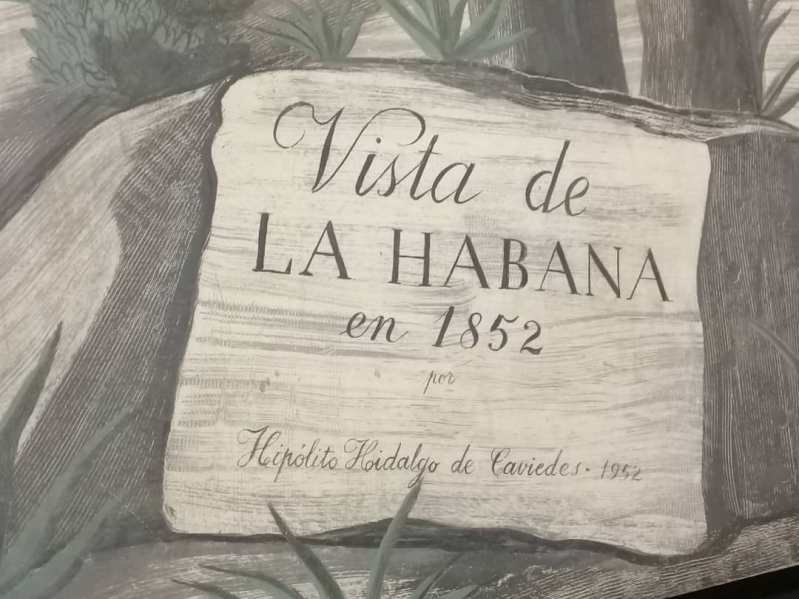
Learn about the history of Havana from a singular work of pictorial heritage.
The mural painting View of Havana in 1852, by Spanish artist Hipolito Hidalgo de Caviedes, is one of the most important heritage works preserved in the city and an excellent gateway to delve into the history of Cuba's largest city.
Habana Radio reports that this pictorial work can be contemplated on Amargura Street and is a project personally conceived by the Historian of the City of Havana, Dr. Eusebio Leal Spengler.
With a beautiful panoramic view of the former Villa de San Cristóbal de La Habana, the piece shows the bay, the Casablanca grounds and the construction of the San Carlos de La Cabaña fortress.
According to this media, the artist took as a reference for his piece an engraving made by Eduardo Laplante in 1852, which can be seen in the "Libro de los ingenios" (Book of Wits).
Previously this mural was located in the building La Metropolitana and it was necessary to relocate it when that place was converted into a hotel.
For such an undertaking, a group of specialists from the Office of the Historian of Havana had to perform the great feat of dismantling it, moving it, protecting it and placing it in a new space.
According to the specialists of the Office of the Historian of Havana, in charge of dismantling, moving, protecting and placing the work in a new space, this has been one of the most important challenges assumed by the office, since it is a work of great dimensions and the handling was very complex.
However, these challenges were overcome and the objective was more than achieved in a work that is considered with protection grade one, due to its high historical and patrimonial value.
The mural, considered with protection grade one, due to its high historical and patrimonial value, managed to recover its brightness and prestige, thanks to the efforts of a multidisciplinary group of the Plaza Vieja Investment Department, who placed it in an innovative room that provides information related to the painter and the work, through technological resources such as wifi, infographics and a graphic that -through the resource of augmented reality-, helps to appreciate all the details.
Habana Radio highlighted the value of augmented reality and the easy access to it, since through wifi the public can load the application on their cell phones and enjoy the entire exhibition, as well as the process of moving and restoring the mural.
In front of this pictorial work, visitors can sit and admire the city from a very comfortable space, but it also allows them to be in a place where they drink from history, the biographical data of the painter and other ten murals made by the Iberian creator in Havana and even in residential buildings, where Hipolito Hidalgo Caviedes left his mark in the early twentieth century.
The beautiful work Vista de La Habana by Spanish artist Hipólito Hidalgo de Caviedes reflects a part of the history of this mythical city told through his pictorial talent and is a delight for Cuban and foreign passers-by.
The outstanding painter Hipólito was born in 1902 in the city of Madrid and since he was a child he showed a vocation for the arts, skills that he developed with his father, painter Rafael Hidalgo de Caviedes.
He studied painting at the San Fernando School of Fine Arts in Madrid, with Aurelio Arteta and Julio Romero de Torres.
In the 1920s he collaborated as an illustrator in magazines such as Blanco y Negro, Mundo Gráfico or La Esfera, while making copies of El Greco in the Prado Museum.
He was a member of the group of Iberian Artists and, as such, he obtained a pension from the Junta de Ampliación de Estudios to go to Italy and Germany, studying mural painting at the Academy of Fine Arts in Florence and at the United State School for the Free and Applied Arts in Berlin.
Upon his return, he settled in Madrid where he painted murals such as the one in the central hall of the Telefonica Building in 1930, the one in the Center of Studies and Permanent Information of Construction in 1934 or the one in the Capitol bar of the same year. In 1936 he traveled to Rome to paint the murals of the Spanish Pavilion at the World Catholic Press Exhibition at the Vatican.
His stay in Spain was brief, because in 1937 he had to leave in exile and took up residence in Havana, where he specialized in mural painting, leaving much of his work in Cuba, the United States and Puerto Rico, where he was appointed director of the Diocesan Museum. The International Exposition of Modern Painting of the Carnegie Institute of Pittsburg awarded him the First Prize in 1935, for the work Elvira and Tiberius.
In Cuba, he participated in group exhibitions in Havana, all with great success; in this city, he married and settled down.
He executed many mural paintings in the Cuban capital, among them the Pedroso Bank, the International Hotel of Varadero and the old building of the Diario de la Marina, today Editora Abril. One of his most outstanding works in Havana, before returning to Spain in 1961, is the large fresco that decorates the triumphal arch of the Belen Chapel.
In 1970 he was appointed member of the Royal Academy of Fine Arts of San Fernando. His speech was on The painter before the wall, since it was on mural painting that he worked most throughout his artistic career, concludes Habana Radio.